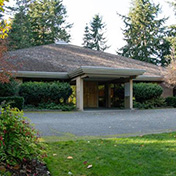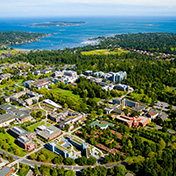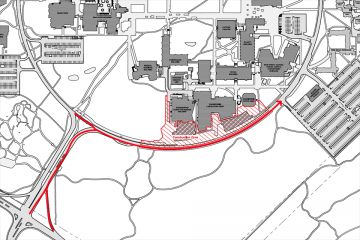Updated Campus Plan finalized

After an extensive 15-month planning and consultation process, and with the formal approval of the Board of Governors on Jan. 26, UVic’s Campus Plan has now been finalized.
Building on UVic’s 2003 Campus Plan, the updated plan providesa refreshed vision, guidelines and direction for future campus development, and responds to new challenges and opportunities. The document covers a planning horizon of 10 years, with longer-term considerations given for the next 25 years, on topics such as building placement and design, transportation, and open and natural spaces. It also plays a key role in supporting the university’s academic priorities and commitments to sustainability.
The new Campus Plan describes the vision of the future campus, rather than detailing specific new building projects or activities. The plan provides the guidelines to be used in future consultations and decision-making.
Principles
The plan lays out nine foundation Principles that will provide guidance for future policy directions and implementation:
- Principle 1– Academic priorities: Development decisions will give priority to the academic, teaching and research needs of the university;
- Principle 2 – Vibrant campus: Establish destinations, uses and services that will enhance the learning environment and help create an active, 24/7 campus;
- Principle 3 –Campus and broader community engagement: An ongoing commitment to continuing and maintaining active collaboration with those impacted by changes, and making the campus navigable and welcoming;
- Principle 4 –Natural areas: A commitment to protecting and restoring designated natural areas on campus;
- Principle 5 –Open space system: Develop and maintain a system of natural and planned open spaces that prioritize pedestrians and cyclists, incorporate creative expression and encourage social interaction;
- Principle 6 –Compact growth: Manage development carefully, seeking to develop a compact campus that encourages synergies and is an efficient use of l#8743;
- Principle 7 –Sustainable buildings and facilities: A commitment to incorporate sustainable practices in the planning, construction and operation of buildings and facilities, creating positive relationships to the open spaces surrounding them;
- Principle 8 –Spirit of place: Continue to plan and design in a way that enhances social interaction on a scale that is friendly to people on foot, further recognizes First Nations history and presence, and preserves the unique Pacific Rim island character of the campus;
- Principle 9 –Movement and accessibility: A commitment to prioritizing pedestrian movement, increasing support for cycling and transit; and minimizing surface parking and dependence on single-occupant vehicles.
Goals
The Campus Plan lays out the four main goals that will guide the vision of a future UVic. In the document, each goal lays out specific policy directions, opportunities and potential actions:
- Natural and landscaped open space goal: Maintain and continue to evolve an open space system which protects and enhances environmentally significant natural areas, provides safe, pedestrian-friendly links throughout the campus, and encourages social interaction through outdoor meeting places, relaxation spaces, playing fields and other outdoor recreational venues.
- Land and buildings goal: Evolve a land-use and building pattern that supports the university’s academic mission, respects the physical environment, creates a welcoming campus, encourages social interaction and activity into the evenings and all week long, and promotes compact, pedestrian-friendly, and sustainable development.
- Movement and accessibility goal: Encourage increased walking or wheelchair use, cycling, and use of public transit, making these priority modes convenient, safe and enjoyable for all users; provide safe access (and reduced demand) for personal vehicles, to help manage pressures on surrounding neighbourhoods.
- Engagement goal: Provide for meaningful engagement of both the campus and broader communities during ongoing implementation of the campus plan, supporting mutual learning and inclusiveness in the campus planning process.
Big Moves
But what does that all mean, on the ground? The plan describes a number of design strategies, or “big moves” that comprise the key physical elements of the concept plan for the future campus:
- A compact campus: Focus new development within and near Ring Road, growing upward rather than outward.
- Ring Road as a people place: Re-imagine Ring Road as a place for peop#8804; a place for walking, cycling, lingering, socializing and more. Numerous options will be studied to determine the most appropriate mixture of pedestrian, cycling and vehicle uses.
- New and invigorated centres of animation: Reinforce existing activity hubs and create new hubs created in under-utilized areas of campus.
- Enhancing cycling and transit:Make cycling and transit use more enjoyable by enhancing the sense of safety and convenience.
- Grand promenade:Strengthen the primary east-west promenade across campus as both a connection and a destination unto itself.
- A focused first phase:Focus the first phase of public realm improvements in the centre of campus, along the primary grand promenade, at key anchors on Ring Road and in areas that would benefit from more natural surveillance.
- Long-term flexibility for outlying lands:Retain flexibility in use for outlying lands—including the Queenswood and Cedar Hill Corner properties and the Ian Stewart Complex—so that they can be utilized to serve UVic’s academic mission as needed.
Implementation of the plan will occur in various incremental steps over the next 10 years, within the guiding foundation of the plan’s vision, goals, principles and policy directions. As each new project is proposed and developed, the support and involvement of students, faculty, staff and community members will be encouraged, welcomed and critical to success, as it has been with the development of the Campus Plan itself.
Photos
In this story
Keywords: administrative





